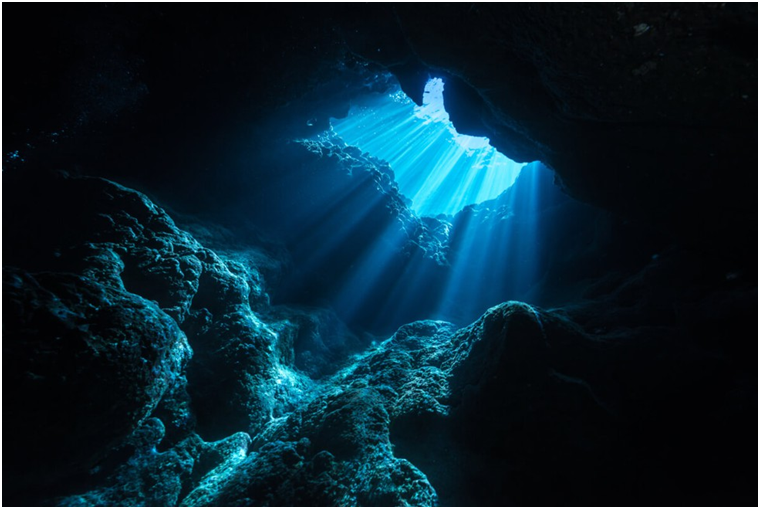
Dark Oxygen
Dark Oxygen
Scientists have recently discovered a strange phenomenon, dubbed “dark oxygen” in the deep sea.

About Dark Oxygen:
- Oxygen that is being produced in complete darkness thousands of feet below the ocean surface is termed dark oxygen.
- Why is the discovery important?
- Until now, it was thought that oxygen was created only through photosynthesis, a process that requires sunlight.
- Oceanic plankton, drifting plants, algae, and some bacteria are the primary elements attributed to the production of oxygen in the ocean. All these organisms are capable of photosynthesis.
- The production of oxygen at such depths is thought to be impossible because there isn’t enough sunlight for plants to do photosynthesis.
- However, in this case, oxygen is not being produced by plants.
- The oxygen comes out of Polymetallic nodules that are similar in resemblance to lumps of coal.
- These nodules, made up of metals like manganese, iron, cobalt, nickel, copper, and lithium, can generate oxygen through electrochemical activity even in the absence of light.
- They are splitting H2O molecules into Hydrogen and Oxygen.
Key Facts about Polymetallic Nodules:
- Polymetallic nodules, also known as manganese nodules, are small, rounded accretions found on the seabed of the deep ocean floor.
- These nodules are composed of a mixture of metals and minerals, including manganese, iron, nickel, copper, cobalt, and traces of other valuable elements such as platinum, rare earth elements, and lithium.
- They form through a slow and gradual process over millions of years.
- They develop as concentric layers around a central nucleus, which can be a shell fragment, a shark tooth, or a piece of basaltic rock.
- The layers are primarily composed of manganese and iron oxides, with other metals being deposited along with them.
- These metals are really important for the production of lithium-ion batteries used in electric vehicle batteries, mobile phones, wind turbines, solar panels, etc.
- They are mainly found in the north-central Pacific Ocean, the southeastern Pacific Ocean and the northern Indian Ocean.
- It is said that there may be enough polymetallic nodules in an area of the Pacific Ocean called the Clarion-Clipperton Zone to meet global energy demands for decades after.
डार्क ऑक्सीजन
वैज्ञानिकों ने हाल ही में गहरे समुद्र में एक विचित्र घटना की खोज की है, जिसे “डार्क ऑक्सीजन” कहा जाता है।
डार्क ऑक्सीजन के बारे में:
- समुद्र की सतह से हज़ारों फ़ीट नीचे पूर्ण अंधेरे में बनने वाली ऑक्सीजन को डार्क ऑक्सीजन कहा जाता है।
- यह खोज क्यों महत्वपूर्ण है?
- अब तक, यह माना जाता था कि ऑक्सीजन केवल प्रकाश संश्लेषण के माध्यम से बनती है, एक ऐसी प्रक्रिया जिसके लिए सूर्य के प्रकाश की आवश्यकता होती है।
- महासागरीय प्लवक, बहते हुए पौधे, शैवाल और कुछ बैक्टीरिया समुद्र में ऑक्सीजन के उत्पादन के लिए जिम्मेदार प्राथमिक तत्व हैं। ये सभी जीव प्रकाश संश्लेषण करने में सक्षम हैं।
- इतनी गहराई पर ऑक्सीजन का उत्पादन असंभव माना जाता है क्योंकि पौधों को प्रकाश संश्लेषण करने के लिए पर्याप्त सूर्य का प्रकाश नहीं मिलता है।
- हालाँकि, इस मामले में, पौधों द्वारा ऑक्सीजन का उत्पादन नहीं किया जा रहा है।
- ऑक्सीजन पॉलीमेटेलिक नोड्यूल से निकलती है जो कोयले के ढेर के समान होती है।
- मैंगनीज, लोहा, कोबाल्ट, निकल, तांबा और लिथियम जैसी धातुओं से बने ये नोड्यूल प्रकाश की अनुपस्थिति में भी विद्युत रासायनिक गतिविधि के माध्यम से ऑक्सीजन उत्पन्न कर सकते हैं।
- वे H2O अणुओं को हाइड्रोजन और ऑक्सीजन में विभाजित कर रहे हैं।
पॉलीमेटेलिक नोड्यूल के बारे में मुख्य तथ्य:
- पॉलीमेटेलिक नोड्यूल, जिन्हें मैंगनीज नोड्यूल के रूप में भी जाना जाता है, गहरे समुद्र तल के समुद्र तल पर पाए जाने वाले छोटे, गोल संचय होते हैं।
- ये नोड्यूल धातुओं और खनिजों के मिश्रण से बने होते हैं, जिनमें मैंगनीज, लोहा, निकल, तांबा, कोबाल्ट और प्लैटिनम, दुर्लभ पृथ्वी तत्व और लिथियम जैसे अन्य मूल्यवान तत्वों के अंश शामिल हैं।
- ये लाखों वर्षों में एक धीमी और क्रमिक प्रक्रिया के माध्यम से बनते हैं।
- वे एक केंद्रीय नाभिक के चारों ओर संकेंद्रित परतों के रूप में विकसित होते हैं, जो एक खोल का टुकड़ा, एक शार्क का दांत या बेसाल्टिक चट्टान का एक टुकड़ा हो सकता है।
- ये परतें मुख्य रूप से मैंगनीज और लोहे के ऑक्साइड से बनी होती हैं, जिनके साथ अन्य धातुएँ भी जमा होती हैं।
- ये धातुएँ इलेक्ट्रिक वाहन बैटरी, मोबाइल फोन, पवन टर्बाइन, सौर पैनल आदि में उपयोग की जाने वाली लिथियम-आयन बैटरी के उत्पादन के लिए वास्तव में महत्वपूर्ण हैं।
- ये मुख्य रूप से उत्तर-मध्य प्रशांत महासागर, दक्षिणपूर्वी प्रशांत महासागर और उत्तरी हिंद महासागर में पाए जाते हैं।
- ऐसा कहा जाता है कि प्रशांत महासागर के क्लेरियन-क्लिपर्टन क्षेत्र में इतने पॉलीमेटेलिक नोड्यूल्स हो सकते हैं कि वे आने वाले दशकों तक वैश्विक ऊर्जा की मांग को पूरा कर सकें।